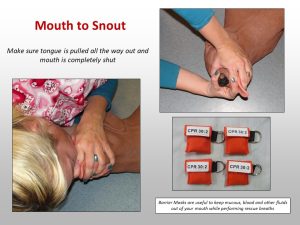PCPR- Lesson 3- Airway and Breathing

The main goals of respiratory support in CPR are to ventilate the animal and increase excreted carbon dioxide produced by the tissues and provide oxygenation which transports oxygen into the blood. There are two types of pressure breaths: spontaneous and positive pressure breaths.
Spontaneous Breaths– This is when negative pressure in the chest draws air into the respiratory system on inhale. This happens during natural breathing.
Positive Pressure Breaths– This is when air is forced into the airway such as in CPR. Serious side effects of CPR can happen if the rescuer uses incorrect ventilation techniques.
Mouth-to-Snout Resuscitation
This is accomplished by pulling out the animal’s tongue, closing the mouth and placing your mouth around both nostrils securely; blowing into the animal’s airway watching for the chest to expand. When you feel resistance as the lungs are inflated, take your mouth off the nostrils and the lungs will deflate. Mouth to snout resuscitation breaths are not effective while the animal is being compressed, therefore you should stop compressions before breathing into the animal’s airway. The reason for this is that air will flow into the esophagus and stomach rather than into the lungs when the lungs are compressed during chest compressions. [4]
